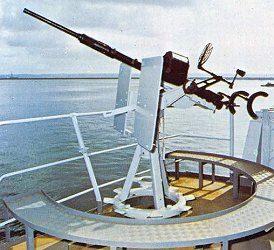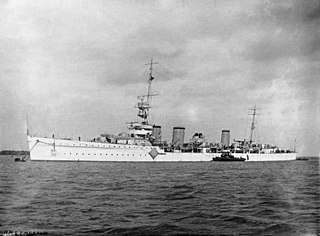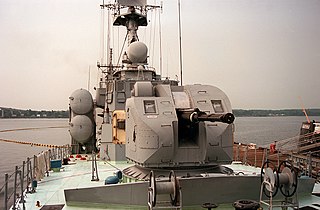
A naval mine is a self-contained explosive device placed in water to damage or destroy surface ships or submarines. Unlike depth charges, mines are deposited and left to wait until they are triggered by the approach of, or contact with, any vessel or a particular vessel type, akin to anti-infantry vs. anti-vehicle mines. Naval mines can be used offensively, to hamper enemy shipping movements or lock vessels into a harbour; or defensively, to protect friendly vessels and create "safe" zones. Mines allow the minelaying force commander to concentrate warships or defensive assets in mine-free areas giving the adversary three choices: undertake an expensive and time-consuming minesweeping effort, accept the casualties of challenging the minefield, or use the unmined waters where the greatest concentration of enemy firepower will be encountered.
Ship commissioning is the act or ceremony of placing a ship in active service and may be regarded as a particular application of the general concepts and practices of project commissioning. The term is most commonly applied to placing a warship in active duty with its country's military forces. The ceremonies involved are often rooted in centuries-old naval tradition.

The German aircraft carrier Graf Zeppelin was the lead ship in a class of two carriers of the same name ordered by the Kriegsmarine of Nazi Germany. She was the only aircraft carrier launched by Germany and represented part of the Kriegsmarine's attempt to create a well-balanced oceangoing fleet, capable of projecting German naval power far beyond the narrow confines of the Baltic and North Seas. The carrier would have had a complement of 42 fighters and dive bombers.

SMS Baden was a Bayern-class dreadnought battleship of the German Imperial Navy built during World War I. Launched in October 1915 and completed in March 1917, she was the last battleship completed for use in the war; two of her sisters—Sachsen and Württemberg—were incomplete when the war ended. The ship mounted eight 38-centimeter (15 in) guns in four twin turrets, displaced 32,200 metric tons at full combat load, and had a top speed of 21 knots. Along with her sister Bayern, Baden was the largest and most powerfully armed battleship built by the Imperial Navy.

SMS Bayern was the lead ship of the Bayern class of battleships in the German Kaiserliche Marine. The vessel was launched in February 1915 and entered service in July 1916, too late to take part in the Battle of Jutland. Her main armament consisted of eight 38 cm (15 in) guns in four turrets, which was a significant improvement over the preceding König's ten 30.5 cm (12 inch) guns. The ship was to have formed the nucleus for a fourth battle squadron in the High Seas Fleet, along with three of her sister ships. Of the other ships only one—Baden—was completed; the other two were canceled later in the war when production requirements shifted to U-boat construction.

A fire-control system is a number of components working together, usually a gun data computer, a director, and radar, which is designed to assist a ranged weapon system in targeting, tracking and hitting its target. It performs the same task as a human gunner firing a weapon, but attempts to do so faster and more accurately.

A research vessel is a ship or boat designed, modified, or equipped to carry out research at sea. Research vessels carry out a number of roles. Some of these roles can be combined into a single vessel but others require a dedicated vessel. Due to the demanding nature of the work, research vessels are often constructed around an icebreaker hull, allowing them to operate in polar waters.

The Oerlikon 20 mm cannon is a series of autocannons, based on an original German Becker Type M2 20 mm cannon design that appeared very early in World War I. It was widely produced by Oerlikon Contraves and others, with various models employed by both Allied and Axis forces during World War II. Many versions of the cannon are still used today.

A target ship is a vessel — typically an obsolete or captured warship — used as a seaborne target for naval gunnery practice or for weapons testing. Targets may be used with the intention of testing effectiveness of specific types of ammunition; or the target ship may be used for an extended period of routine target practice with specialized non-explosive ammunition. The potential consequences of a drifting wreck require careful preparation of the target ship to prevent pollution, or a floating or submerged collision risk for maritime navigation.

Anti-submarine warfare is a branch of underwater warfare that uses surface warships, aircraft, submarines, or other platforms, to find, track, and deter, damage, and/or destroy enemy submarines. Such operations are typically carried out to protect friendly shipping and coastal facilities from submarine attacks and to overcome blockades.

The Emerald class or E class was a class of two light cruisers built for the Royal Navy. Following the Cavendish class, three ships of a new class were ordered in March 1918, towards the end of World War I, designed to emphasise high speed at the cost of other qualities, for use against rumoured new high-speed German cruisers – like the Brummer class – and particularly minelayers, in the North Sea. However, the third ship was cancelled in November 1918.
The Le Hardi class consisted of twelve destroyers built for the Marine Nationale during the late 1930s. Only seven ships were ultimately completed while construction of the remaining five ships was interrupted by the French defeat in the Battle of France in May–June 1940 and were never finished. The seven ships that were seaworthy sailed for French North Africa to prevent their capture by the advancing Germans. Several ships later sailed for French West Africa where Le Hardi played a minor role in the Battle of Dakar in September. The Germans captured two ships that were still under construction and attempted to finish them both before abandoning the effort in 1943.

The LBD-1 Gargoyle was an American air-to-surface missile developed during World War II by McDonnell Aircraft for the United States Navy. One of the precursors of modern anti-ship missiles, it was extensively used as a test vehicle during the late 1940s.

The 15 cm SK L/45 was a German naval gun used in World War I and World War II.

The Blohm & Voss BV 143 was an early prototype rocket-assisted glide bomb developed by the German Luftwaffe during World War II.

The AK-176 is a Soviet naval gun mounted in an enclosed turret, that may be used against sea, coastal, and aerial targets, including low flying anti-ship missiles. The system is designed to arm small displacement ships and comprises the Gun Mount with a MR-123-02/76 Fire Control Radar System. It has high survivability owing to autonomous use of the gun mount controlled from the optical sight in the absence of control from the radar system, as well as a capability for fire even if power supply is lost.

The 8.8 cm SK C/35 was a German naval gun used in World War II.
The Type 909 weapon trial ship and its successor Type 909A Dahua class are Chinese weapon trials ships developed for its People's Liberation Army Navy (PLAN). A total of three ships have entered service as of mid-2014.
The Yanxi class weapon trials ship is a class of little known naval auxiliary ship of the People's Liberation Army Navy (PLAN). The name of this class is after the first unit commissioned, with the exact type still remains unknown. Contrary to the usual naming conventions of Chinese military where the ship is designated by a combination of two Chinese characters followed by three-digit number, the Yanxi class is designated by only a single Chinese character, which is Xun (训), short for Xun-Lian (训练), meaning training in Chinese, because these ships of this class is also used as training ships, but only a single unit of this class has been built. However, the pennant numbers may have changed due to the change of Chinese naval ships naming convention.
The JARI USV is an unmanned surface vehicle developed by the China Shipbuilding Industry Corporation (CSIC), specifically between its No. 716 Research Institute, the Jiangsu Automation Research Institute (JARI), and No. 702 Research Institute, China Ship Scientific Research Centre (CSRRC). The unmanned warship is designed for potential use for the People's Liberation Army Navy and export customers.
















